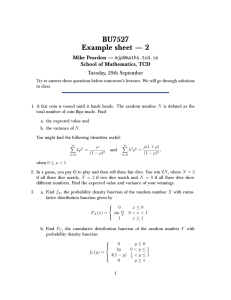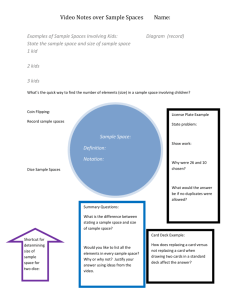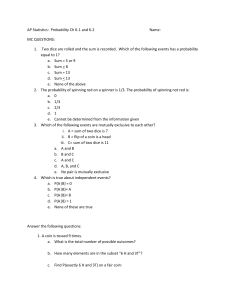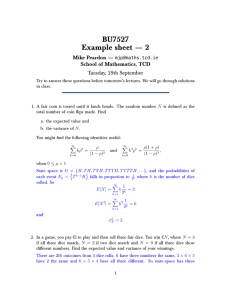Document 10540764
advertisement
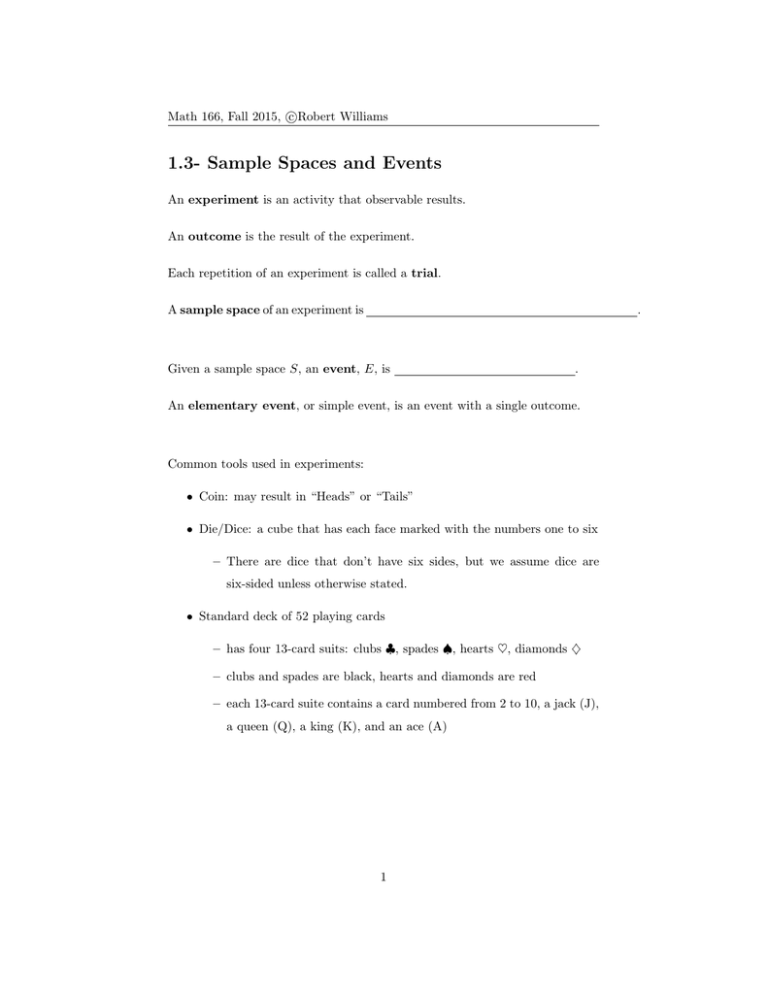
c
Math 166, Fall 2015, Robert
Williams
1.3- Sample Spaces and Events
An experiment is an activity that observable results.
An outcome is the result of the experiment.
Each repetition of an experiment is called a trial.
A sample space of an experiment is
.
Given a sample space S, an event, E, is
.
An elementary event, or simple event, is an event with a single outcome.
Common tools used in experiments:
• Coin: may result in “Heads” or “Tails”
• Die/Dice: a cube that has each face marked with the numbers one to six
– There are dice that don’t have six sides, but we assume dice are
six-sided unless otherwise stated.
• Standard deck of 52 playing cards
– has four 13-card suits: clubs ♣, spades ♠, hearts ♥, diamonds ♦
– clubs and spades are black, hearts and diamonds are red
– each 13-card suite contains a card numbered from 2 to 10, a jack (J),
a queen (Q), a king (K), and an ace (A)
1
c
Math 166, Fall 2015, Robert
Williams
Example 1 Write the sample space of the following experiments:
a) recording whether the price of gas rises, lowers, or stays the same over the
course of a month
b) recording the outcome of flipping a coin and rolling a die
c) recording the outcome of simultaneously rolling two identical dice
d) recording the outcome of rolling two different colored 4-sided dice
Important: When an experiment consists of multiple tasks, determine whether
or not one is capable of distinguishing between them. Look for key words like
“identical”, “different”, “order matters”, and “order doesn’t matter”
Example 2 Answer the following questions about the sample space from Example 1 part d:
a) What is the event “At least one die rolls a 4”?
b) What is the event “Both dice roll a 4”?
c) How many events are in the sample space?
2
c
Math 166, Fall 2015, Robert
Williams
It is sometimes helpful to make a tree diagram for experiments where we
complete multiple tasks in succession. We let each set of branches represent the
individual tasks in the experiment with a branch for every possible outcome.
Here is a tree diagram for flipping two coins where the order is important
H
H
T
H
T
T
Draw a tree diagram for the experiment “We record the outcome of a coin flip
and then draw a card from a standard deck and record its suit.”
3
c
Math 166, Fall 2015, Robert
Williams
The empty set, ∅, is called the impossible event and the sample space, S, is
called the certain event.
All of our set operations make sense in the language of events as well. Let E
and F be two events.
• E ∪ F is the union of E and F , the event that consists of all outcomes in
E or F
• E ∩F is the intersection of E and F , the event that consists of all outcomes
that are in both E and F
• E C is the complement of E, the event that consists of all outcomes that
are not in E
• E and F are called mutually exclusive if the sets are disjoint. That is,
E∩F =∅
Example 3 Consider the experiment where we roll two dice and record thier
sum. Let F be the sample space “the sum is 5”, LE the sample space “the sum
is less than or equal to 8”, MS the sample space “the sum is greater than or
equal to 7”, and E the sample space “the sum is 11”. Write the following sample
spaces:
• F ∪E =
• F ∪ MS =
• (LE )C =
• LE ∩ MS =
• F ∩E =
4
c
Math 166, Fall 2015, Robert
Williams
Sometimes sample spaces are continuous and we cannot list each individual
outcome. In this case, we write sample spaces and events using set-builder
notation. For example, if I were to measure the height of every student in
the class, I could get as precise as I want (maybe one student happens to be
48.341004592 inches tall). In this case, we define the sample space as
S = {h|h > 0, h is in inches}.
Example 4 A race is held where each participant is to run from one endzone to
the other in Kyle Field. The time it takes each participant to finish is recorded.
• Write the experiment’s sample space
• Write the event “finish in under 100 seconds”
• Write the event “finish in between 30 and 60 seconds”
5
